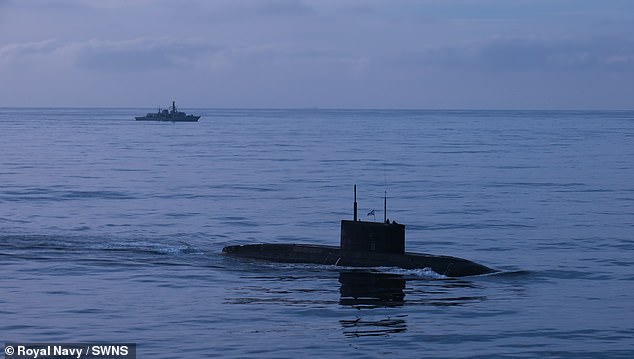A Russian submarine’s secretive mission took a dramatic turn when it was forced to surface near France after suffering a serious malfunction at sea.
The Novorossiysk, a diesel-powered attack submarine belonging to Russia’s Black Sea Fleet, reportedly developed a fuel leak while crossing the Strait of Gibraltar, forcing it to limp back home through the English Channel.
The 230-foot vessel, which carries a crew of about 50, was monitored by several European forces as it slowly made its way from the Mediterranean to the North Sea.
A Slow and Unsteady Return Home
According to Dutch defense officials, the damaged submarine was towed through the North Sea after being tracked surfacing near Brittany, France.
Its visible presence drew widespread attention because Russian submarines rarely travel surfaced unless something has gone wrong.
Despite reports from Western intelligence about a possible fuel leak, Moscow quickly denied any technical issues.
Russia’s Black Sea Fleet insisted that the submarine surfaced only to comply with “international maritime protocols.”
British Forces Step In to Monitor Movements
The Royal Navy wasted no time keeping a close watch on the situation.
As the Novorossiysk entered British waters, the frigate HMS Iron Duke—based in Plymouth—was deployed to shadow the vessel for three days.
Supporting the mission was a Wildcat helicopter from 825 Naval Air Squadron, which tracked and photographed the submarine’s movements through the English Channel.
British authorities emphasized that these surveillance missions are routine but vital to ensuring the safety and transparency of maritime activity in their region.
NATO Calls Out Russia’s Weakening Naval Power
NATO’s Secretary General, Mark Rutte, didn’t hold back when addressing the submarine’s troubles.
Speaking at a defense conference in Slovenia, he described the Novorossiysk’s plight as a symbol of Russia’s declining naval strength.
“There’s hardly any Russian naval presence left in the Mediterranean,” he said.
“Now we’re watching a lone, damaged submarine crawl home from patrol.
What a contrast to the powerful image once depicted in The Hunt for Red October. Today, it’s more like the hunt for the nearest mechanic.”
A Once-Feared Submarine Now Struggling for Survival
Commissioned in 2014, the Novorossiysk was once seen as a formidable force.
It is designed to carry Kalibr cruise missiles, capable of striking targets from thousands of miles away, and can operate at depths nearing 1,000 feet with an impressive range of 7,500 nautical miles.
But this latest incident paints a grim picture of a vessel that may no longer live up to its once-feared reputation.
Tensions in British Waters Continue to Rise
This is not the first time the Royal Navy has had to track Russian warships near the UK.
Just weeks before the Novorossiysk’s episode, HMS Iron Duke was again called into action—this time to shadow the Russian frigate Neustrashimy and cargo ship Sparta IV as they moved through the North Sea and the Channel.
British Defence Minister Luke Pollard warned that Russian ships have been transiting these waters more frequently, underscoring the importance of the Royal Navy’s around-the-clock vigilance to protect national interests and NATO’s maritime frontlines.
The Aftermath of Ukraine’s Resistance at Sea
Since the start of the war in Ukraine, Moscow’s navy has faced devastating losses.
The most symbolic blow came when Ukrainian missiles sank the Moskva, the flagship of Russia’s Black Sea Fleet.
Struck by two Neptune anti-ship missiles, the Moskva became the largest Russian warship lost in combat since World War II.
Nearly 400 sailors were evacuated, though at least one died and 27 remain unaccounted for.
The incident highlighted how much Russia’s naval dominance has eroded under constant pressure from Ukrainian defenses.
A Struggling Fleet Facing Mounting Challenges
The Novorossiysk’s mechanical issues and humiliating journey through NATO waters only add to the growing perception that Russia’s naval power is faltering.
Once a symbol of stealth and strength, the submarine now represents a fleet stretched thin by war, sanctions, and aging equipment.
Western analysts say that without major investment, Russia’s navy will continue to face operational setbacks—both above and below the surface.
Share on Facebook «||» Share on Twitter «||» Share on Reddit «||» Share on LinkedIn